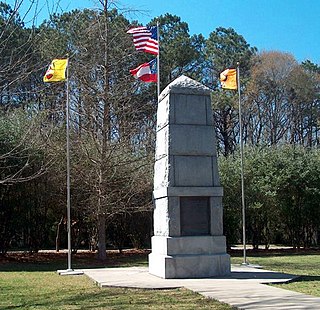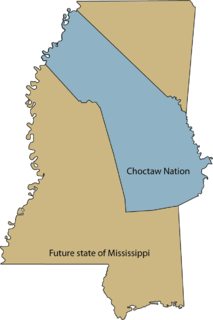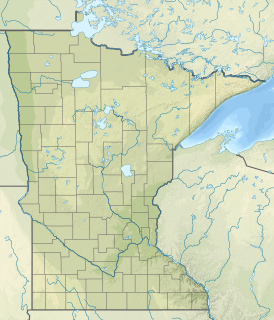
The Trail of Tears was part of a series of forced displacements of approximately 60,000 Native Americans between 1830 and 1850 by the United States government known as the Indian removal. Members of the Cherokee, Muscogee (Creek), Seminole, Chickasaw, and Choctaw nations were forcibly removed from their ancestral homelands in the Southeastern United States to areas to the west of the Mississippi River that had been designated 'Indian Territory'. The forced relocations were carried out by government authorities after the passage of the Indian Removal Act in 1830. The Cherokee removal in 1838 was brought on by the discovery of gold near Dahlonega, Georgia in 1828, resulting in the Georgia Gold Rush.

Tippah County is a county located on the northern border of the U.S. state of Mississippi. As of the 2010 census, the population was 22,232. Its county seat is Ripley. The name "Tippah" is derived from a Chickasaw language word meaning "cut off." It was taken from the creek of the same name that flows across much of the original county from northeast to southwest before emptying into the Tallahatchie River. The creek probably was so named because it, and the ridges on either side, "cut off" the western part of the region from the eastern portion.

Tallahatchie County is a county in the U.S. state of Mississippi. At the 2010 census, the population was 15,378. Its county seats are Charleston and Sumner.

Allamakee County is the northeasternmost county in the U.S. state of Iowa. As of the 2010 census, the population was 14,330. Its county seat is Waukon.

Corinth is a city in and the county seat of Alcorn County, Mississippi, United States. The population was 14,573 at the 2010 census. Its ZIP codes are 38834 and 38835. It lies on the state line with Tennessee.

Laurel is a city in and the second county seat of Jones County, Mississippi, United States. As of the 2010 census, the city had a population of 18,540. It is located northeast of Ellisville, the first county seat, which contains the first county courthouse. Laurel has the second county courthouse as there are two judicial districts in Jones County. Laurel is the headquarters of the Jones County Sheriff's Department, which administers in the county. Laurel is the principal city of a micropolitan statistical area named for it. Major employers include Howard Industries, Sanderson Farms, Masonite International, Family Health Center, Howse Implement, Thermo-Kool, and South Central Regional Medical Center. Laurel is home to the Lauren Rogers Museum of Art, Mississippi's oldest art museum, established by the family of Lauren Eastman Rogers.

The Tennessee River is the largest tributary of the Ohio River. It is approximately 652 miles (1,049 km) long and is located in the southeastern United States in the Tennessee Valley. The river was once popularly known as the Cherokee River, among other names, as the Cherokee people had their homelands along its banks, especially in what are now East Tennessee and northern Alabama. In addition, its tributary the Little Tennessee River, flowed into it from Western North Carolina and northeastern Georgia, where it also was bordered by numerous Cherokee towns. Its current name is derived from the Cherokee town, Tanasi, which was located on the Tennessee side of the Appalachian Mountains.

The Treaty of Dancing Rabbit Creek was a treaty signed on September 27, 1830, and proclaimed on February 24, 1831, between the Choctaw American Indian tribe and the United States Government. This was the first removal treaty carried into effect under the Indian Removal Act. The treaty ceded about 11 million acres (45,000 km2) of the Choctaw Nation in what is now Mississippi in exchange for about 15 million acres (61,000 km2) in the Indian territory, now the state of Oklahoma. The principal Choctaw negotiators were Chief Greenwood LeFlore, Mosholatubbee, and Nittucachee; the U.S. negotiators were Colonel John Coffee and Secretary of War John Eaton.

The Tombigbee River is a tributary of the Mobile River, approximately 200 mi (325 km) long, in the U.S. states of Mississippi and Alabama. Together with the Alabama, it merges to form the short Mobile River before the latter empties into Mobile Bay on the Gulf of Mexico. The Tombigbee watershed encompasses much of the rural coastal plain of western Alabama and northeastern Mississippi, flowing generally southward. The river provides one of the principal routes of commercial navigation in the southern United States, as it is navigable along much of its length through locks and connected in its upper reaches to the Tennessee River via the Tennessee-Tombigbee Waterway.

De Soto National Forest, named for 16th-century Spanish explorer Hernando de Soto, is 518,587 acres of pine forests in southern Mississippi. It is one of the most important protected areas for the biological diversity of the Gulf Coast ecoregion of North America.

Tombigbee National Forest is a U.S. National Forest in eastern and northeastern Mississippi. It is named for the nearby Tombigbee River. It is divided geographically into two non-contiguous sections. The larger southern section, about 60% of the total acreage, is located north of Louisville, in parts of Winston, Choctaw, and Oktibbeha counties in eastern Mississippi. The smaller northern section, about 40% of the total acreage, is located northeast of Houston, in parts of Chickasaw and Pontotoc counties in northeastern Mississippi. As a whole the forest lies, in descending order of land area, in Winston, Chickasaw, Choctaw, Pontotoc, and Oktibbeha counties. The forest has a total area of 67,005 acres. Headquarters of forest administration is in Jackson, as are those for all six National Forests in Mississippi, but local ranger district offices are located in Ackerman. The forest contains the Owl Creek Mounds, which include five platform mounds built between 1100 and 1200 CE.
The Pine Belt, also known as the "Piney Woods", is a region in Southeast Mississippi. The region gets its name from the longleaf pine trees that are abundant in the region.

Wells Creek is a 27.6-mile-long (44.4 km) tributary of the Mississippi River in Wabasha and Goodhue counties in Minnesota, United States. It enters the Mississippi at Old Frontenac.

Deer Creek is a creek in the U.S. state of Mississippi. Its source is Lake Bolivar, in Scott, Bolivar County, Mississippi.

Mooreville, sometimes misspelled as Mooresville, is an unincorporated community and census-designated place (CDP) in Lee County, Mississippi, United States. As of the 2010 census the population was 650. It was named for the Moore family, its first settlers.














